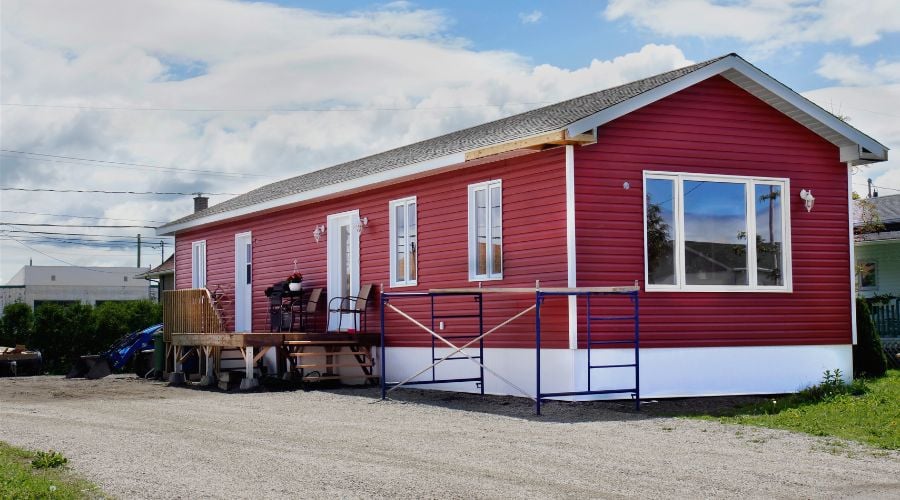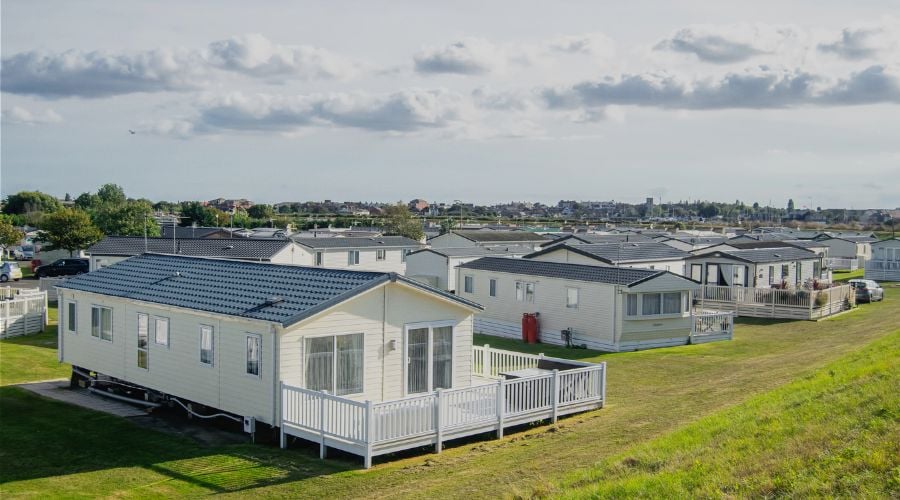A Manufactured Home Buyer's Guide
GET FREE QUOTESBuyer's Guide to Manufactured Homes
Whether you are a first-time homebuyer or just new manufactured homes, this guide can help you get up to speed on all the things you need to know before making a purchase. Manufactured homes provide real value and are cost-effective solutions for housing needs. However, is it the right decision for you? Let’s find out!
What is a Manufactured Home?
A manufactured home, formerly known as a mobile home before June 15, 1976, is a prefabricated home that can be transported to a location. Mobile homes are now known as manufactured homes because they now follow the rules and regulations by HUD surrounding construction. Before June 15, 1976, they were known only as mobile homes.
What Makes Manufactured Homes Different than Stick-Built Homes?
Stick-built homes are built on-site and can generally not be moved. Manufactured homes are built in a factory using an assembly line-style process. Because manufactured homes are built inside a factory, where they follow optimized processes, manufactured homes can be built in just a couple of days or up to 5 weeks according to New Home Source. This is much quicker than traditionally built homes which can take months if not a year or more depending on the size and features.
Purchasing a Manufactured Home
When it comes to purchasing a manufactured home, you’ll want to use an authorized dealer within your state. This means that they are certified by the state you live in and must adhere to certain building instructions, insurance requirements, and more. Buying from a licensed retailer ensures that your transaction is lawful and that the home’s warranty, which covers construction and material faults, is valid and enforceable. While this is dependent on the state, this is generally accepted. Moreover, authorized dealers will be familiar with your state regulations surrounding delivery and setup.
Types of Manufactured Homes
Because manufactured homes are built on an assembly line in a warehouse they are built in two main types of form factors. These include:
Single-wide:

According to Rocket Mortgage, these trailers typically are between 12ft-18ft wide and 40ft-80ft long. Single-wide manufactured homes are generally smaller and can be more easily moved.
Double-wide:

Double-wides are generally going to be around 24ft-160ft wide and around 80ft-160ft in length. They are generally double the size of a single-wide. While a single-wide may be 2 or 3 bedrooms, a double-wide can be 4+ bedrooms. Unlike single-wides, double-wides are made up of two independent pieces that are produced and delivered separately before being combined on-site. This sort of home often has a more classic domestic layout.
Custom Manufactured Homes:
There is the option to have a custom-manufactured home. It is uncommon, however, it is possible. These houses are custom-built to the buyer’s requirements. You won’t have the same flexibility as a stick-built home, you can still have a custom design. These custom options are more expensive than the traditional single-wide and double-wide.
Choosing the Right Type
Before choosing the right manufactured home for you, there are some things you should consider such as:
- Budget: The bigger or more customized, the more expensive.
- Land: Are you purchasing land alongside your manufactured home?
- Growth: Does the manufactured allow you to expand say for a growing family?
- Zoning Restriction: Are there certain ordinances that prevent you from putting a specific type of manufactured home in a certain location?
Advantages of Manufactured Homes
There are many advantages to manufactured homes, especially cost conscience buyers. Some of the advantages may include:
Cost-Effective Housing Solution
Manufactured homes are often less costly per square foot than traditional stick-built homes. This is because they are built in a factory and don’t have to deal with wealth delays or have to adhere to the specific standard of stick-built homes. Furthermore, mass purchase of materials and faster building procedures lower prices.
Quick Construction
Manufactured homes can be built relatively quickly, in a matter of days eve. From start to finish, a buyer could in a new home within 4-5 months. Compare this to traditional homes and it is a much faster process.
Energy Efficiency
The modern manufactured home is designed to be energy efficient. A HUD-compliant home must meet federal standards for insulation, windows, and heating/cooling systems that are energy-efficient. These specifications and updated building methods have made these buildings much more efficient and cost-effective.
Can Be Delivered
A home can be designed and built while you are still looking for the land. You don’t have to have the land already before purchasing. This means you can find the best spot for you while your house is being built!
Customization Options
You don’t have to have a fully customized manufactured home to have some customization. Contrary to popular belief, manufactured homes offer a ton of customization even in their standard houses. Whether that be installing certain trims, countertops, appliances, etc.
Disadvantages of Manufactured Homes
While there are many upsides to manufactured homes, there are some downsides we must acknowledge.
Depreciation
Unlike conventional stick-built homes, these types of homes typically lose value over time. This depreciation might reduce the home’s resale value, making it a less attractive long-term investment in some situations. Manufactured homes are also generally harder to resale.
Financing and Insurance Challenges
While it is true that there are many financial services that are willing to lend money for manufactured homes, not all will. Moreover, many financial institutions that will lend money to you often have restrictions on how much you can borrow for manufactured homes. Meaning you wouldn’t be able to borrow as much as you would with a stick-built home.
Land Issue
Unlike traditional homes, purchasing a manufactured home does not include any land purchase. Just the home. You’ll then have to find land to put the home on. The land purchase is an additional price that you have to configure into your price. Additionally, finding a suitable plot of land that allows for manufactured homes can be difficult due to zoning laws and community covenants. Manufactured home parks are also an option but come with their own complications such as predatory practices.
Regulatory and Zoning Challenges
There are certain regulations and zoning laws that can affect where you put a manufactured home. For example, certain housing communities will not allow you to put houses in certain neighborhoods.
Preparing to Establish Your Manufactured Home
Before your manufactured home can be delivered, you’ll need to do some site preparation and make sure you are ready to go.
Obtain Necessary Permits
You’ll want to make sure you obtain any necessary permits before delivery. This will be dependent on the county and state you live in. Consider permits such as:
- Zoning permits
- Building permits
- Electric permits
- Plumbing permits
- Driveway and sidewalk permits
- And others depending on your state
Prepare the Site
Site preparation is a critical step that involves:
- Clearing the land for the home to be delivered
- Leveling the ground so the structure can be instructional sound
- If necessary install a foundation whether that be a concrete slab, piers, etc.
- Arrange for the installation of utilities
Once the home is installed, you’ll need to perform an inspection as damage can happen during the delivery and setup. This inspection ensures you make the most of your insurance and warranty policy.
Inspect the Home After Delivery
You’ll want to have a checklist of items to review once your house is in place, consider things like:
- Doorways are opening and closing by yourself
- Chips, cracks, or damage
- Window seals
- Cracks in the walls
- Utility connections
- Water damage and connections
- Roof damage
- Base stabilization
- The A/C working properly and has a filter
- Make sure your adaptors and meter box are up to date
- Make sure there is no damage to the appliances
You can also consider hiring an inspector to help you inspect the new home and make sure you are fully prepared to move in.
After Your Manufactured Home Has Been Delivered
Once your manufactured house is built, you’ll need to maintain that new home and ensure it has a long lifespan.
Maintenance and Upkeep
- Yearly Inspections: Check the roof, foundation, and exterior walls of your house annually for damage or wear. Check for leaks, cracks, or mold.
- Proper Ventilation: Ensure your home is properly ventilated so moisture doesn’t accumulate in your home, causing mold to grow.
- Add Skirting: Skirtings protect the underside of your home from pests and weather as well as improve aesthetics.
- Heating and Cooling Systems: Make sure that your HVAC system is serviced regularly to ensure its efficiency. Filters need to be cleaned or replaced, ductwork should be inspected, and the thermostat should be checked.
Warranty
As the years go on, it will become more and more important to have a verified warranty with an authorized dealer. Sometimes, there is damage that can happen that can’t be detected upon initial inspection. That warranty can help protect you from having to pay additional costs. Your warranty may cover things like:
- Appliances
- Structural integrity
- A/C systems
- And more.
Cost of Manufactured Homes
According to Village Homes, the cost for manufactured homes is around $55 to $85 per square foot. However, this does not include taxes, the cost of land, delivery, and appliances.
Need a Manufactured Home?
Are you considering purchasing a manufactured home for you and your family? 360Connect can help! Just fill out our 1-2 minute form and we’ll contact you to verify your information and needs. From there, you will be contacted by up to 5 different suppliers. It’s that simple.
